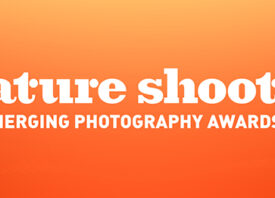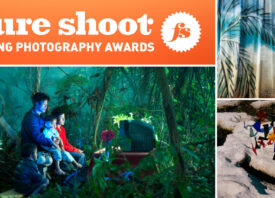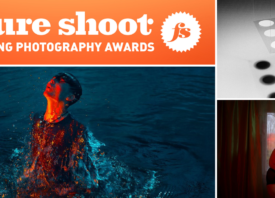Search this site
Announcing the Winners of the 2018 Feature Shoot Emerging Photography Awards!
After reviewing hundreds of phenomenal submissions from photographers working across the globe, we’re thrilled to announce the ten winners of the 4th Annual Feature Shoot Emerging Photography Awards. One up-and-coming photographer, selected by Feature Shoot Founder Alison Zavos, will receive a cash prize of $5000, and nine more will exhibit with one of our esteemed jurors: Louise Clements of FORMAT International Photography Festival in the UK, Moshe Rosenzveig of Head On Photo Festival in Sydney, or Laura Roumanos of United Photo Industries in Brooklyn, New York.
Exhibiting images will be shown as as stunning ChromaLuxe metal prints, trusted by gallerists and museums around the world for their vibrancy and durability. Special thanks to Squarespace, the all-in-one platform to build your online presence, for sponsoring the awards! Photographers can try Squarespace free for 14 days. When you’re ready to subscribe, be sure to use coupon ‘FSAWARDS18’ for 10% off your first purchase.

© Lucia Sekerkova
Feature Shoot Founder Alison Zavos selected Lucia Sekerkova as the winner of the $5000 cash prize. In her series Vrajitoare, the Slovakian photographer tells the stories of Romanian Wallachian Roma women. As modernization collides with the traditional roles of witches, fortune tellers, and healers, these women are sought-after online. “The profession has been transformed into a business, inherited across generations,”Sekerkova writes. “Nine-year-old girls are already starting their promotional ‘vrajitoare’ profiles on the Facebook.”
Louise Clements, the Artistic Director QUAD and the Director of FORMAT International Photography Festival selected a total of five photographers to be part of a group exhibition at the FORMAT19 Festival in the UK: Lucia Sekerkova, (see above) Synchrodogs, Sharbendu De, Camillo Pasquarelli, and Dylan Hausthor.

© Lucia Sekerkova

Untitled #2 from Slightly Altered project © Synchrodogs
For their series ‘Slightly Altered’, Synchrodogs, an artistic duo composed of Tania Shcheglova and Roman Noven, take us to the Carpathian Mountains, where they spent a month traveling and reflecting on the complex relationship between humankind and the wilderness. “The project is about interdependency of humans and nature and the new ways the Earth begins to look as a result of our interventions into the environmental processes,” they write. “Witnessing intrusions into nature, Synchrodogs have started reflecting upon how much we, like all life, both alter our environment and are altered by it.”

© Sharbendu De
The Indian photographer Sharbendu De takes us to the forests of Namdapha National Park & Tiger Reserve in Arunachal Pradesh, where he spent time with members of the the Lisu tribe. Though they are Indian citizens, the Lisu people have experienced decades of isolation, oppression, and loss. In 1983, their ancestral land was converted into a national park without their consent. “A largely unadministered terrain, they survive without roads, electricity, schools, doctors, hospitals, phone network or most modern amenities,” De writes. “Despite the adversities, they cohabit symbiotically with nature –– revelling in its mysteries as a self-sufficient community. They treat their sick, build each other’s home, pray, celebrate and mourn together.”
For his series Imagined Homeland, he’s constructed lyrical tableaux with members of the tribe. “I intend to evoke feelings that portray their state of mind and emotions over resorting to a spectacle,” he continues. “I adopted poetic aesthetics, reference archetypal interconnections between man, animal and nature, and borrow from dream symbolism.” You can read our interview with De here.

Amir Kabir Beigh, 26 years old, Baramulla. “In September 2010 I was going to buy some medicine for my mother by evening time when a group of security forces fired at me near the bridge of the old town. There had been clashes throughout the day but it was calm at that time. I was alone on the street so only after some minutes somebody found me and took me to the hospital. I have gone through a lot of surgeries all over India but I am still completely blind”. Amir is the first pellet victim of Kashmir, he received hundreds of iron balls on his body. © Camillo Pasquarelli
In the project The valley of shadows, Camillo Pasquarelli takes us to the militarized zone of the valley of Kashmir, tracing the stories of individuals who have been affected by the pellet guns used by security forces.”Defined as a ‘non-lethal’ weapon, it should be aimed at the lower part of the body during the urban protests,” the Italian photographer writes. “According to a UN report released in 2018, the new weapon is responsible for blinding around 1000 people and killing dozens. Many of the victims were not involved in the clashes with security forces. Those who were hit during the protests tend to avoid speaking about it openly, fearing retaliation by the police. For youngsters left with one eye reading has become too painful, thus forcing them to abandon their studies, giving up the chance of pursuing higher education. Men left blind, the only breadwinner in the family, are unable to work and provide for their beloved ones.”

Dead Men, Look at Me © Dylan Hausthor
An unusual thing happened in Dylan Hausthor’s town: a friend of his lit another friend’s barn on fire, and in the midst of the deed, she went into labor. “She ran across the street to the property owner’s house demanding a ride to the hospital as the proof of her arson was smoking right behind her,” the photographer writes. Inspired in part by this event, his series Past the Pond, Setting Fires takes a poetic approach to the thin and mysterious line that separates the idea of truth from fiction, reality from mythology. “The characters and landscapes in these images are documents of the instability found in storytelling—told by an even more precarious narrator,” Hausthor continues.”I’m interested in pushing past questions of validity that are traditional in documentary photography and into a much more human sense of reality: faulted, broken, and real.”
Moshe Rosenzveig, the Founder and Director of Head On Photo Festival, chose three artists to exhibit in Sydney: Jordan Gale, Gloria Oyarzabal, and Gary Beeber.

Portrait of myself. Family photo. North Liberty, IA. 2018 © Jordan Gale
In It Is What It Is, the Iowa photographer Jordan Gale revisits his upbringing in Cedar Rapids, a nuanced history touched by drug dependency and poverty. “It creates a portrait of youth and decrepitude, addiction and recovery, all coexisting in a Midwest town,” the artist writes. “Through a personal narrative, the series highlights the frustration, sorrow, and longing of multigenerational stagnation in America’s Heartland.”

STUDIO STRIPES (On exotification, hypersexualization, victimization and other -ations) © Gloria Oyarzabal
The Madrid-based photographer Gloria Oyarzabal dismantles Western colonial ideas on gender in her project Woman go no’gree. “One consequence of Eurocentrism is the racialization of knowledge: Europe is represented as the source of knowledge and Europeans, therefore, as thinkers.In addition, male privilege as an essential part of the European ethos is implicit in the culture of modernity,” the artist writes. “I explore the intersections of gender, history, knowledge-making, stereotypes, clichés.”

Gary Beeber, a photographer and filmmaker based in Centerville, OH, looks beyond the surface of things to reveal nuances and details others might overlook. This particular image comes from his series Sylvester Manor. “Unbeknownst to me, this hauntingly bucolic overgrown garden was the former slaveholding planation purchased in 1652 by Nathaniel Sylvester for 1600 pounds of sugar,” the artist writes. “I find myself compelled to chronicle it’s evolving decay while attempting to understand its complex history.
Laura Roumanos, the Executive Producer & Co-Founder United Photo Industries will show work by two artists–Amelie Satzger and Lauren Menzies–in a dual exhibition at the UPI gallery in Brooklyn, New York.

Time Dilation © Amelie Satzger
With What is Reality?, the Munich-based photographer Amelie Satzger invites us into a surrealist universe inspired by the works of Stephen Hawking. Every image in the series illustrates one of the concepts set forth by the preeminent theoretical physicist.

Femme Fiction #1 © Lauren Menzies
Femme Fiction is a series of self-portraits by the New York City photographer Lauren Menzies; in each picture, she reveals a facet of her personality (i.e. a “persona”). “Using myself as the figure, I explore the history of female portraiture through ideas of beauty, irony, and perception,” she writes. “The figure’s features are removed to aesthetically disguise the immediate recognition of self-portraiture. This shapes my desire for the viewer to imagine a story about each woman.”
The Feature Shoot Emerging Photography Awards are generously sponsored by Squarespace, ChromaLuxe United Photo Industries, Head On Photo Festival, and FORMAT International Photography Festival.



